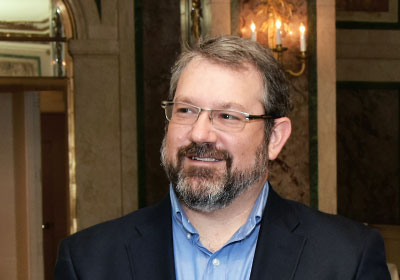NIMH Research Seeks to Harness Power of Technology, Says Gordon
Abstract
Powerful computing techniques, sophisticated imaging systems, and improved collection of data are advancing NIMH’s research mission.
When Joshua Gordon, M.D., Ph.D., became director of the National Institute of Mental Health (NIMH) in 2016, he wanted to pay special attention to three areas among the many in the institute’s portfolio: suicide, neurocircuits, and computation. Suicide takes an unacceptable toll every year. Neurocircuits were revolutionizing knowledge of anxiety-like patterns in the mouse brain and needed to be applied to human illness. Computational psychology was an all-encompassing technology, embracing biophysics, computational phenotyping, and machine learning.

Big data, big computing, and a big focus on getting results to patients are guiding the research directions for Joshua Gordon, M.D., Ph.D., director of the National Institute of Mental Health.
“We wanted to look at research that can influence clinical treatment in the next few years, but also how to put into action what we know now and who will respond to treatment,” said Gordon at the 175th History Track session titled “Shaping the Future of Psychiatry Through Research and the Delivery of Care” at APA’s 2019 Annual Meeting in San Francisco. “We also want to support investigation into how the brain works and how it integrates with the social and physical environment.”
Basing the diagnosis and treatment of mental illness in the patient’s underlying neurobiology is the goal of Alan Anticevic, Ph.D., an associate professor of psychiatry at Yale University School of Medicine. Anticevic is exploring neurobiologically grounded ways of analyzing mental illness using pharmacological neuroimaging and computational modeling. Those approaches could lead to more accurate diagnoses and to personalized treatments, he said. He has used data from his own and others’ collections of brain scans. Sharing such data among labs is critical for advancing the field.
“Data collection is incredibly important,” he said, calling for greater access to existing databases of material on the human cerebral cortex.
Another approach combines the focus on suicide with the power of technology and computation, said fellow panelist Matthew Nock, Ph.D., a professor of psychology at Harvard University. Research to date usually has focused on the same suicide-related risk factors, most of which have small effect sizes. Nock and his colleagues with the Army Study to Assess Risk and Resilience in Servicemembers (STARRS) employed machine-learning techniques to analyze combined risk-factor data from medical and administrative records on 53,769 psychiatric hospitalizations. They found that people in the top 5% of the risk scores accounted for 53% of suicides.
The dearth of research on the weeks immediately prior to suicide “is the biggest limiting factor to helping us understand suicide,” said Nock. Most studies have looked at risk as far back as five to 10 years prior to suicide and is confounded by recall bias. About 7% of research covers one to six months before the event. Just 0.1% has looked at the 30 days before suicide—presumably the most useful period for clinicians.
Nock is looking at the multiple technologies incorporated in cell phones for help in “digital phenotyping” of people at risk for suicide. “How do people’s thoughts and feelings change as they move into suicidal episodes?” he asked.
Researchers have installed apps on the phones of high-risk individuals, and they “ping” them four to six times a day to ask about suicidality. Certain patterns in their responses have correlated so far with increased risk for suicide attempts.
A more passive approach that combines the phone’s global positioning system accelerometer, calling, texting, and Bluetooth system also is under investigation. Initial results: More texting is linked to fewer suicide attempts, possibly because the individuals are engaging with friends and family.
Cheryl King, Ph.D., a professor of psychiatry at the University of Michigan, compared rising youth suicide rates with the “dramatic” decline in traffic fatalities over the last two decades; suicide has not received the public health attention that traffic safety has. Screening might identify youth at risk for suicide, but no single risk factor has proven useful, although analyzing multiple risks might be valuable.
Several suicidal screening protocols exist. King and her colleagues are developing and evaluating a new suicide risk screening strategy, the Computerized Adaptive Screen-Teen Suicide Risk (CASSY), which adapts questions to prior responses. An initial large-scale study found CASSY to result in fewer false positives (higher specificity). A validation study is under way with 4,000 adolescents. In other analyses of this dataset from over 2,000 adolescent emergency department patients, the researchers identified predictors of suicide attempts within three months. They found that a multiple-risk factor approach achieved a classification accuracy of .86. The key factors proved to be current suicidal ideation, lifetime suicidal ideation severity, lifetime history of suicidal behavior, and school connectedness.
Post-screening treatment has produced mixed results. Beyond psychotherapy, a youth-nominated support team (YST) has shown some promise among young people hospitalized for suicide risk. The teenager picks up to four adults whom the program then supports, she said. A YST study of 448 adolescents found a greater decrease in suicidal ideation at 12 months, as well as more therapy sessions, drug treatment, and medication follow-up visits. Eleven to 14 years later, 13 deaths had occurred in the treatment-as-usual group, compared with two in the YST cohort.Altogether, these technologies produce volumes of data that can be analyzed in ways unavailable in smaller, conventional studies and provide new insights for diagnosis, intervention, and treatment. ■



